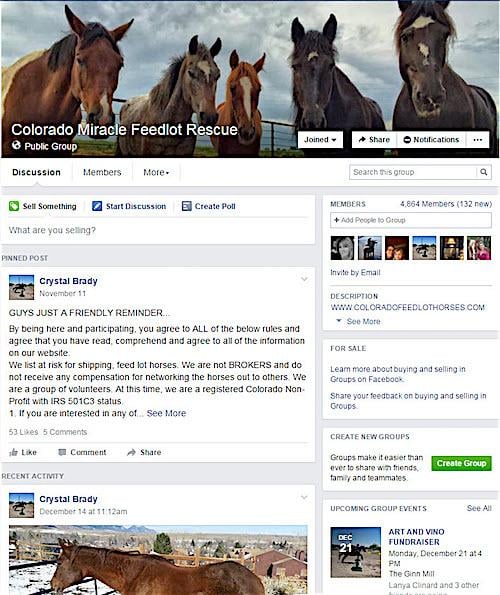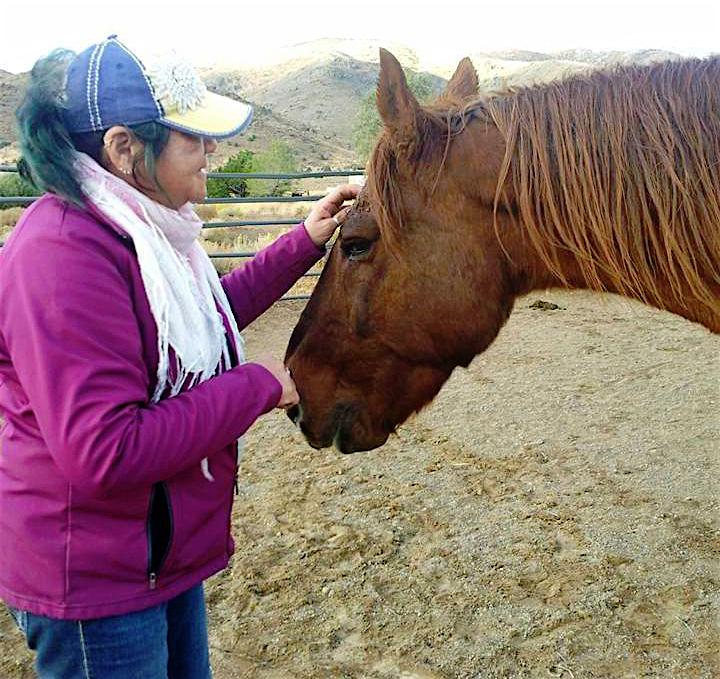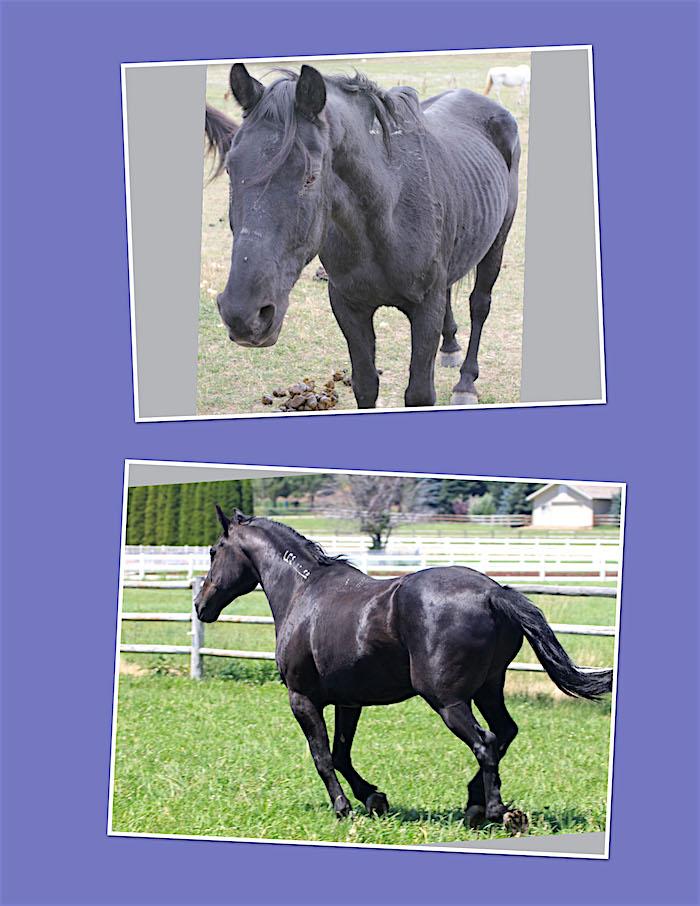Editor's note: This updates the story with reference to a National Park Service policy pertaining to disposing of horses and mules.
My first partner in my first job with the National Park Service was a dark bay mare. I was extremely popular with the kids when I’d show up at the General Sherman Tree or Lodgepole Campground in Sequoia National Park riding Sweets. So you can imagine the shock and horror I felt last August when I learned that three NPS horses were on a feedlot in Colorado, waiting to be shipped to a slaughterhouse in Mexico.
In September of 2014, my husband and I rescued our first kill pen horse: a coal black, BLM-branded mustang in his mid-20s. Since then we’ve been able to do the same for 19 other horses in the same predicament. I regularly monitor Facebook pages that list these equines-in-need, and in August I spotted a photo of a big sorrel horse with the caption: “Fern, NPS Horse.” I scrolled further and found two more: a black and white paint gelding named Fairplay, and a big, thin sorrel gelding named Norman. All three of these beautiful, fit-looking NPS horses were at immediate risk of being “shipped.” I was stunned. How could we allow an NPS horse to end its career at a slaughterhouse?
Although most people don’t know it, the horse slaughter industry is alive and thriving in the United States. Ten years ago, Congress passed an act prohibiting the use of federal funds to inspect horse slaughterhouses, which ultimately led to closure of all facilities in the United States. It’s still legal, however, and lucrative, to ship horses to slaughterhouses in Canada or Mexico.
According to the Humane Society of the United States, “Slaughter is a brutal and terrifying end for horses, and it is not humane. Horses are shipped for more than 24 hours at a time without food, water, or rest in crowded trucks. They are often seriously injured or killed in transit. Horses are skittish by nature (owing to their heightened fight-or-flight response), which makes accurate pre-slaughter stunning difficult. As a result, horses often endure repeated blows and sometimes remain conscious during dismemberment—this is rarely a quick, painless death.”
Fortunately, numerous people are working to end the transport of horses for slaughter in the United States, and to save horses that find themselves in the “slaughter pipeline.” A horse enters this pipeline when a “kill buyer” finds a free or inexpensive animal advertised on Craigslist or in the newspaper, or buys horses at public auctions. In most cases, the horses are hauled to feedlots, where they are microchipped for shipping and fattened up on substandard feed before being hauled to the border. The fatter the better; the horses will be sold by the pound.
Groups in several states try to find homes for the feedlot horses before they ship. In these situations, the kill buyers charge a few hundred dollars more per horse than they would get from the killers. Many groups use Facebook pages to post photos of the kill-pen horses. For some horses, limited information is provided: sex, approximate age, and deadline (when the horse is scheduled to ship). Occasionally, there are a few notes: "very friendly," "sound," "injury to left leg," "said to be broke." The price also is posted, usually ranging from $200 for a yearling to $1,000 for a big draft horse. The rescuers sometimes give the horses names.
When the three NPS horses popped up on my screen, I immediately shared their pictures on the slim chance someone might recognize them. Over the next few days, two of the horses were saved by people I don’t know, but no one was stepping up for Norman.

Groups concerned about the welfare of horses operate Facebook pages that track horses headed for slaughterhouses with hopes someone will buy the horses before they're shipped.
I put out a call for help, and was contacted immediately by several former and present NPS employees. The Santa Monica Mountains Fund provided Norman’s bail to get him off the feedlot, and several individuals pulled together money to transport him to a safe foster home, and to cover his board while in foster care. In a wonderful gesture of kindness and generosity, one former NPS employee, Kat Gonzales, even offered Norman a forever home.
After we got him hauled off the feedlot, Norman was quarantined at a foster facility for 30 days, because horses from auctions and feedlots are under great stress and often are exposed to numerous equine diseases. The quarantine period helps prevent a new owner from taking a horse home and exposing their other horses. At the end of Norman's quarantine, he was moved to his new retirement home in Minden, Nevada. A GoFundMe account was set up to pay for Norman’s ride to Nevada, as well as hoof trimming, vet bills, and lots of horse treats.
So this story had a happy ending. Fern, Fairplay, and Norman got lucky; very lucky. But these horses, who likely worked very hard for the National Park Service, came too close to ending their lives in terror at a Mexican slaughterhouse. This raises serious questions:
* How did they end up in the slaughter pipeline?
* What NPS policy is in place to ensure that hard-working equine rangers are guaranteed a safe retirement?
* Were Fern, Fairplay, and Norman simply unfortunate exceptions, or are numerous former NPS horses landing on slaughter lots and meeting gruesome ends?
While handling the logistics of getting Norman safe, healthy, and settled in his new home, a few of Norman’s supporters attempted to contact NPS managers to alert them to the fact that NPS horses were showing up on slaughter lots, and to inquire about NPS policy for retired equines.
Phone calls weren't returned and emails generated no response. The Yellowstone Park Foundation (although polite and seemingly sympathetic) reported that they were not “privileged to release information” about equine retirement policies in the NPS. When a manager in the NPS’s Washington, D.C., Visitor and Resource Protection (VRP) Branch office finally responded, he told us to submit a Freedom of Information Act request. We are waiting for the information from this request.

"Norman" and Kat at his new foster home/Photo courtesy of Kat Gonzales
What we do know is that the NPS defines live animals as property; basically, the same as a desk, gun, computer, or toilet brush. In the NPS Handbook for Director’s Order #44 (Personal Property Management), live animals are included on the list of “excess personal property” that can be donated to other entities. If such an animal is auctioned, there is a clause in DO44 that may prohibit anyone who had “prior contact with the item” from bidding. So if I had wanted to purchase the mare I rode on patrol in Sequoia after she was done with her career, I probably wouldn't have been allowed to do so. Treating live animals the same as any other type of property is outdated and demeaning to these public employees, and is likely one of the primary reasons retiring equines are showing up on kill lots.
How could an NPS horse land on a feedlot that ships horses to slaughter? There are many ways it could happen, but it starts when a horse like Norman gets too old to do his job, or when the park where he is working decides to terminate their equine program. The park contacts a local horse rescue operation and asks for help in finding Norman a safe and comfortable retirement home. The rescue group finds Norman a home. Norman’s new owner dies, and the rescue is not notified of the person’s death. The heirs take Norman to a local auction, where he is purchased by a “kill buyer.” Or the new owner finds herself in a financial crisis and can’t keep Norman. Instead of contacting the rescue, she takes him to an auction. Few people know that all horses sold at auctions in the United States are at high risk of being purchased by a kill buyer. Approximately 130,000 horses per year are shipped out of the United States for slaughter every year.
National Park Service officials in Washington, D.C., however, cited a provision for disposing of horses and mules unfit for continued service.
§ 1308. Disposition of unfit horses and mules
Subject to applicable regulations under this subtitle and division C (except sections 3302, 3501(b), 3509, 3906, 4710, and 4711) of subtitle I of title 41, horses and mules belonging to the Federal Government that have become unfit for service may be destroyed or put out to pasture, either on pastures belonging to the Government or those belonging to financially sound and reputable humane organizations whose facilities permit them to care for the horses and mules during the remainder of their natural lives, at no cost to the Government.
That said, some horses and mules apparently fall through the cracks. Some parks relocate horses to other NPS units, which can be successful, but also has ended in at least one horse’s death when the receiving park employees were not horse savvy. Other parks work with local equine rescue groups to find homes for the retirees, and some horses have been passed on to nearby police departments.
Several years ago a now-retired NPS employee involved with Yosemite’s horse program drafted a retirement plan for NPS horses and sent it to NPS’s property management office in Washington, D.C., but the draft plan seems to have dropped out of sight.
On a brighter note, it became clear during our investigation that many NPS employees are very concerned about the fate of the agency’s hard-working equines after they retire. Sadly, as with so many other issues within NPS, these employees are afraid to speak out about their concerns because doing so could compromise their jobs.
In 2000, H.R. 5314.ENR, also called "Robbie’s Law," was passed to facilitate the adoption of retired military working dogs. It is time for the Department of the Interior to promote a similar law (perhaps named Norman’s Law?) that would address the lives of working equines and other service animals from the time they are acquired to the time they are laid to rest.
Norman cannot tell us what his job was with the NPS. Unless someone recognizes him and steps up to tell us his story (and he is, by the way, easily recognizable by his very large size, his white star and strip, and his brushy moustache), we will never know what services he performed. Did he pull a wagon or sleigh? Did he walk long distances in the backcountry to rescue injured hikers? Did he proudly carry a ranger in the front country, having his photograph taken by thousands or millions of park visitors? If I had not seen the NPS horses on Facebook and if others had not immediately been willing to help, Norman, after his years of dedicated service, might have, in the words of one of his key supporters, “become a taco.”
The year 2106, when the NPS celebrates its centennial, is a perfect time for the Service to establish a rock-solid plan and policy to ensure NPS equines are safe and healthy in their retirement years. Let’s hope the agency will step up and take full responsibility for these horses who have been such reliable and beloved public employees. It’s the right thing to do.

These before and after photos demonstrate the rebound a horse can make after being rescued from a feedlot and nursed back to good health/Barbara Moritsch






 Support Essential Coverage of Essential Places
Support Essential Coverage of Essential Places







Comments
I don't think the slaughter is univeersal. Here at North Cascades complex. The person in charge of the trail horses is actively seeking good homes for retired NPS horses.
It just seems to me that a simple top-down policy of benevolence would solve what appears to be a widely variable situation.
Thanks for all of the information. I was supporting several feedlot groups until I did some research. The owners of the lots now can make a quick buck From horse advocates, and are buying up horses that in the past would've sold at the auction to good homes. It was very disturbing what was going on. I talked to others who adopted from the feedlot groups and the horses werent properly quarantined. One woman lost one of her best horses at home that way, The new horse brought in strangles or some other disease I believe. Just didn't feel like the best answer to me in many ways. The feedlot websites are visible and they bring in so many people trying to rescue the horses that the kill buyers have incentive to snatch Up quality animals and put them through hell. Not good.
I work at a National Park and we have horses. Believe me, this would not happen here, we have people lined up to adopt them. They are not old enough to retire, but when they do, we will be there. Also, we do not brand our horses. I have not seen that done before. Our horses are nurtured, and have a job every day. We love them. I am sorry this happened to these other NPS horses. They deserve respect and a full retirement, as all horses do!!!!
Not all retired NPS Horse Patrol horses end up in kill pens. Our retired park horses went to a local rescue where they were carefully adopted out. The "property" person at each park has the option of what to do with the horses. They are allowed to be adopted out by the NPS. If your park admin has a heart, they will be safe at the end of their careers.